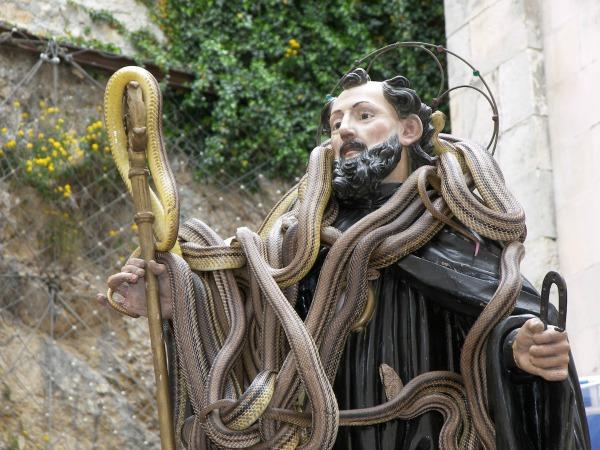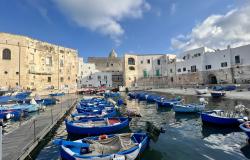Words by Nick Hankins
"Fa brutto tempo", the station master cries, throwing his arms up to the heavens. But as another ice-cold wind blows, his smile and vigorous handshake offer the perfect antidote.
On the first Thursday in May, I awake at a painfully early hour to join the hundreds of pilgrims heading for the tiny village of Cocullo.
I make my way to the centre of the village, where the flocks of people thicken and the main piazza is crowded. The road leading out is packed with food stalls and reverberates with loud music.
Il Rito dei Serpari
Here in the mountainous Abruzzo, perhaps the wildest region in Italy, untamed nature and unabashed folklore bare their teeth. Hidden away in breathtaking Apennine ridges at the heart of the peninsula, there are glimpses into an intriguing way of life which more modern regions have simply passed by.
Some years ago, a local anthropologist, Emiliano Giancristofaro, took the lid of this unusual area in a series of radio broadcasts entitled Il Mangiafavole. He depicted a world of popular belief in magic and witchcraft, of evil spells and special charms, of werewolves and lunar influence. He interviewed people who were versed in the art of premonition by dreams, practised alternative medicine, and performed bizarre pagan rituals of marriage and death. But strangest of all was the cult of San Domenico in Cocullo – Il Rito dei Serpari (festival of the snake charmers).

Charming people
The origins of the cult are truly ancient. The Marsi tribe, native here 2,000 years ago, bore an Italic culture which survived the Roman policy of centralisation. They were famed for their serpent-charming skills, which were put to good use in clearing the snake-infested streets of Rome. They formulated panaceas from the heads of vipers, and their magic spells were invoked to cure poisonous bites. In the spring, they would offer a tribute of live snakes to the pagan serpent goddess Angizia, a tradition which survived well into the middle ages.
Enter Domenico di Foligno, a Benedictine abbot who wandered the Abruzzo performing miracles. Like San Francesco, these miracles involved wild animals. At Pretoro, he persuaded a wolf to return a baby it had snatched from a forester couple, while at Cocullo he liberated the locals from the bites of vipers and other poisonous snakes.
For his deeds, Domenico was canonised in 1104, and the Christian figure of the saint became superimposed on the pagan cult of Angizia. The patron saint of protection from snake bites, he became the liberator of the soul from the most reviled snake of them all – Satan. Rabid dog bites and tooth-ache were also a part of his miracle-curing portfolio; splinters of wood from the bench he slept on are believed to have miraculous dental powers.
A saint with teeth
As I approach the village, a powerful sense of anticipation looms, nowhere more so than during the non-stop masses at the small sanctuary of San Domenico. Soon I am shaking hands with my neighbours, and shuffling past the Saint’s statue along a dark passage. Within, people collect handfuls of white-coloured earth they will use to ward off snakes.
They kiss the sacred molar of the Saint, and approach the chain of a small bell. ‘San Domenico has magical pliers to pull out bad teeth,’ the toothless lady in front explains. ‘Ring the bell with your teeth, and toothache is banished‘. I decide to give it a miss.
In the small piazza fronting the sanctuary, a company of pilgrims has just completed an excruciating 30-kilometre journey on foot from the village of Atina. Their solemn cross-bearer is accompanied by two zampognari (bagpipers), endlessly repeating a monotonous tune. But all of this is a side-show to the real action.
At twelve noon, the crowd is packed so tightly I cannot move. Suddenly, a priest bursts forth from the sanctuary and demands space. Two girls wearing enormous hats, resembling the Queen of Hearts in Alice in Wonderland, lead a procession of brass-band players and statue-bearers. The crowd pushes in as the serpari, who have spent the last few weeks coaxing wild snakes from the countryside, do their work. And then the statue of San Domenico is raised for all to see.
Not for the faint-hearted
This is the moment we have all been waiting for. The statue has become a writhing, flesh-creeping mass of snakes. They slither, they wriggle, they dangle. They coil around the neck and arms and torso of the Saint. They pull back their heads as they shake their forked tongues at us. The crowd falls silent. Someone beside me gasps.
As the procession winds its way around the village, moving up and down the alleys and around the piazzas, it is followed by a hysterical phalanx of onlookers and photographers. As the drizzle sets in, the snakes writhe more than ever, while the youthful gaze of the exactly 900-year-old Saint remains unperturbed. By the time the procession stops to provide him with a personal firework display, snakes are sliding free. Some have been adopted as temporary pets, which may seem foolhardy but the snakes are not venomous. When the procession returns to the sanctuary, the snakes are once again liberated.
As Giancristofaro points out, in a world where globalisation is leading to a gradual loss of cultural identity, the survival of this timeless tradition takes on a deeper importance. At least this tiny corner of Italy looks set to hold on to its unique cultural identity for many years to come.
How to get to Cocullo
BY AIR: Pescara International Airport
BY TRAIN: Direct Sulmona-Cocullo
BY CAR: Autostrada A25 Pescara-Roma
The Festival is every May. At noon, avoid the dangerous rugby scrum outside the sanctuary; watch the snake-draping from the balcony above the piazza – the view is much better.





